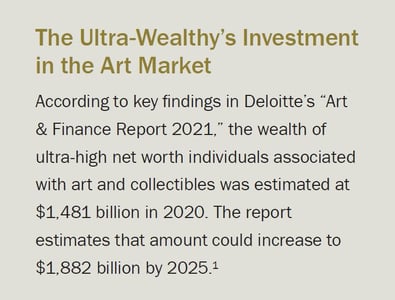4 min read
Ways to Include Art and Collectibles in Your Estate Plan
 Brian Humes, CPA, Managing Director, Commerce Family Office, St. Louis
:
May 17, 2023 7:00:00 AM
Brian Humes, CPA, Managing Director, Commerce Family Office, St. Louis
:
May 17, 2023 7:00:00 AM

Individuals acquire fine art pieces and collectibles for various reasons, as this is their investing style. Perhaps buyer impulse takes over when a person sees a painting in a gallery or at auction and just “has to have it.” It could be the end result of one’s lifelong search for that “perfect” piece to complement a personal collection. Another might have a genuine passion and love for the art world and collects works by a particular artist or from a certain period in history.
For many collectors, they consider art to be one of the most lucrative investments for their portfolios, particularly during times of market volatility.

If you are an avid collector, perhaps you have acquired pieces for one of the reasons mentioned above — or, you may have any number of other personal motivations for searching the world for the fine art pieces you cherish.
Whatever the case may be, it is important that you think about the protection and preservation of your art collection by arranging for its disposition in your estate plan and working with an executor or trustee who is knowledgeable about gifting collectibles. The following suggestions may serve as a guide to get you started.
Considerations for including fine art in your estate plan
Have all documentation for your art pieces in good order.
Gather all paperwork and provenance documentation relating to each piece in your collection, including bills of sale, invoices, correspondence, photographs, serial numbers, identifying marks, and, of course, appraisals and insurance information.
Properly organize and catalog all available information for each piece and store your records in a safe place. Transfer documentation to digital records for convenient access (online inventory management systems are available to assist with this part of the process).
Once completed, give a copy of the detailed inventory list to your legal and estate planning professionals responsible for the disposition of your assets upon your death. According to the findings in Deloitte’s report, only 12 percent of the collectors surveyed had taken this important step to formalize their art inventories with their estate planning advisors.2
Think through your plans well in advance.
It’s difficult to be objective about the pieces in your art collection. After all, you invested a substantial amount of time, effort, and capital in them, and pride in ownership is only natural. When planning for their disposition in your estate plan, you should be realistic about what each piece will mean to others — try not to let your biases and passions misguide you.
Not everyone views your art the same way you do, so you need to carefully consider which family member or friend really wants or deserves each piece in your collection. Before deciding about the disposition of your fine art, have candid, personal conversations to determine which pieces you want to gift them in your estate plan. Talk about your sentimental attachment to each piece and invite input from others. Mediate disagreements among family members over specific art pieces early on rather than leaving those arguments for your attorneys to settle later.
Also, you may want to consider an additional cash gift to beneficiaries to help them cover the costs of owning your artwork, and fully explain to each beneficiary the continuing obligations of artwork ownership.
Consider other gifting alternatives.
Perhaps giving your art collection to a favorite gallery or museum is preferable to passing on specific pieces to close friends and family members. This option not only would ensure the professional care and preservation of your collection but also would allow your pieces to be viewed, studied, and enjoyed by countless art lovers who share your passion for years to come.
Another alternative is to organize the sale of your art collection after your death and give away the proceeds. It is not uncommon that family members would rather have other assets such as cash or stocks instead of fine art pieces. If you decide to sell your collection, take an active part in the disposition process with your estate planning professionals. You do not want the art pieces to be sold at auction after your death for less than their market value.
Maintain important professional relationships.
Once you’ve made all the decisions regarding the future of the pieces in your art collection, we suggest the following:
- Maintain relationships with the art dealers, galleries, museums, auction houses, appraisers, and insurance providers — anyone that you want involved with the disposition of your collection after your death. Inform them of your decisions regarding the disposition of the pieces in your art collection. You may want to introduce family members and estate planning professionals to these individuals to facilitate an easier transition of the assets when the time comes.
- Immediately document your decisions with your estate planning attorneys and financial advisors.
- Verify your executors and trustees are comfortable working with fine art collections and will properly execute the disposition of the pieces.
Ensure your wishes will be honored.
Commerce Trust can connect you with attorneys, members of the art community, and estate planning professionals who specialize in the evaluation and disposition of fine art collections. Our professional advisors will help you articulate your vision, work with you and your estate planner to document your wishes, and transfer your collection as planned. Contact us today.
¹ Deloitte, “Art & Finance Report 2021: Key findings,” pages 19, https://www2.deloitte.com/lu/en/pages/art-finance/articles/art-finance-report.html
2 Deloitte, “Art & Finance Report 2021: Key findings,” pages 34, https://www2.deloitte.com/lu/en/pages/art-finance/articles/art-finance-report.html
The opinions and other information in the commentary are provided as of May 17, 2023. This summary is intended to provide general information only, and may be of value to the reader and audience.
This material is not a recommendation of any particular investment or insurance strategy, is not based on any particular financial situation or need, and is not intended to replace the advice of a qualified tax advisor or investment professional. While Commerce may provide information or express opinions from time to time, such information or opinions are subject to change, are not offered as professional tax, insurance or legal advice, and may not be relied on as such.
Data contained herein from third-party providers is obtained from what are considered reliable sources. However, its accuracy, completeness or reliability cannot be guaranteed.
